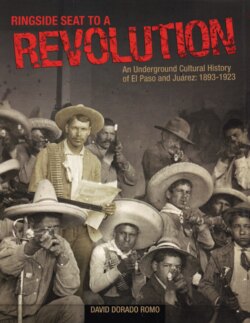Читать книгу Ringside Seat to a Revolution - David Dorado Romo - Страница 27
На сайте Литреса книга снята с продажи.
Оглавлениеthe United States and Mexico and a major center for
smelting, cattle, mining and other products of
binational trade. City boosters claimed El Paso’s
geographic location made it “the best pass across
the Continental Divide between the equator and the
North Pole.”15 It was one of the fastest growing cities
in the Southwest and had a population—according to
the 1896 El Paso City Directory—of 15,568. About
60% of the inhabitants were of Mexican descent;
although they were not officially segregated, most of
the El Paso Mexicans lived in an area south of
Overland Street.
For the next few
decades, its rail-
22
road connections
and the concentra-
tion of Mexican
residents would
make El Paso an
ideal location
from which to plot
a revolution.
The Chinese
Exclusion Act of
1882 had trans-
formed El Paso
into a major cross-
ing point for illegal
Chinese immigra-
tion into the
Listening to McGinty Band concerts at San Jacinto Plaza
on weekends was a popular form of entertainment for
United States. A
large number of
the city’s court
cases were either
related to Chinese
immigration or to the local opium trade. Most of the
individuals charged with maintaining “a disorderly
house”—the codeword for opium dens—almost
invariably lived in Chinatown. (Other popular crimes
in 1896, judging from the local police records, were
sexual crimes—fornication and adultery—which
would usually end up costing the violator $50 or sev-
El Pasoans during the turn of the century, 1896.
(El Paso County Historical Society.)
eral days in jail.)
A less risky form of recreation at the time was
taking strolls to San Jacinto Plaza on weekends to
hear city-sponsored McGinty Band concerts. One his-
torian described the McGinty Band as “a group of
musicians and beer drinkers who hauled countless
kegs of El Paso beer and provided many hours of
entertainment for fellow El Pasoans.”16 It was the
same musical group that had played while the cloud-
seeding experiment took place on the Franklin
mountains that year. Scientific American magazine
sponsored the experiment to ascertain whether or not
it would rain if cannon balls were shot into the clouds.17
El Pasoans could also attend musical and theatri-
cal performances at the Myar Opera House, the most
prestigious stage in town. On October 15, 1896,
Teresita Urrea took a rest from performing miracles to
sing and play the gui-
tar for guests at her
birthday celebration.
That same evening,
the Myar Opera
House scheduled a
different kind of mira-
cle—the screening of
the first silent movies
ever shown in the
city. But the first
screening fell through
because the Vitascope
projector only worked
on direct current;
only alternating cur-
rent was available in
the city. When the
moving pictures were
finally shown a week
later, the audience
was greatly amused
by the scenes of a
man kissing a big-
chinned woman named May Irvin; a bicycle parade;
a bathing scene; and two “negroes” stereotypically
enjoying their watermelon—a scene which, accord-
ing to the El Paso Herald, brought great guffaws from
the crowd. There was also a moving clip shown that
evening that was only described in the evening pro-
gram as a “lynching scene celebration.”18
For the more active types, bicycle races were very
popular. In 1896, El Paso’s Euro American women
were still talking about Annie Londonderry’s stopover
in the city a couple of years before as part of her 15-
month bicycle trip around the world. The women
were shocked and harshly critical of Londonderry for
15
El Paso Chamber of Commerce. Prosperity and Opportunities in El Paso and El Paso’s Territory for the Investor-Manufacturer-Jobber-Miner-
Farmer-Home Seeker.
16
Frank Mangan, El Paso in Pictures, p.41.
17
Conrey Bryson, Down Went McGinty: El Paso in the Wonderful Nineties.
18
Willivaldo Delgadillo and Maribel Limongi, La Mirada Desenterrada, p. 175.
